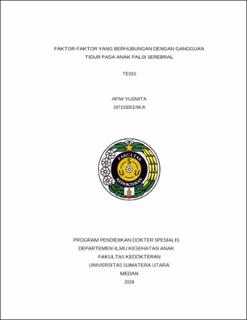| dc.contributor.advisor | Sofyani, Sri | |
| dc.contributor.advisor | Siregar, Rosmayanti Syafriani | |
| dc.contributor.author | Yusnita, Afni | |
| dc.date.accessioned | 2025-01-10T04:30:02Z | |
| dc.date.available | 2025-01-10T04:30:02Z | |
| dc.date.issued | 2024 | |
| dc.identifier.uri | https://repositori.usu.ac.id/handle/123456789/100034 | |
| dc.description.abstract | Background : Children with sleep disorders are children whose sleep quality and quantity are disturbed. This situation often occurs in children with chronic diseases such as cerebral palsy (CP). Sleep disorders in CP children can disrupt physical, emotional and cognitive development and can affect parents' physical and psychological health. Therefore, it is important to screen for sleep disorders in CP children.
Objective: Determine the prevalence and factors associated with sleep disorders in children with CP
Methods: Cross-sectional design analytical study on PS palsy children aged 4-10 years at Haji Adam Malik Hospital Medan during March-August 2023. Sleep disorders were assessed using the Children's Sleep Habit Questionnaire (CSHQ). Data regarding CP type, motor function disorders based on the Gross Motor Functional Classification System (GMFCS), epilepsy, anti-epileptic drugs (AEDs), and anti-spastic drugs were obtained from medical records. Bivariate analysis to determine the relationship between demographic characteristics and sleep disorders. Multivariate analysis to analyze the relationship of various variables with sleep disorders.
Results: Sixty children with CP were included in this study, the majority were of the spastic type (75.3%) and did not use anti-spastic drugs (85%). Based on the degree of motor function impairment, 63.4% were non-ambulatory CP. Most subjects had epilepsy (63.3%) and used AED monotherapy (73.7%). Sleep disorders occur in 80% of CP children, with the highest proportion of sleep disorders being breathing disorders during sleep (58,2%).The bivariate analysis obtained that spastic CP and non-ambulatory CP significantly correlated with sleep disorders in CP children (p=0.025; p=0.001).The multivariate analysis obtained that non-ambulatory CP children had a 4.28 times risk to sleep disorders (OR 4.23; 95% CI 1.92-15.84; p=0.03).
Conclusion: Sleep disorders are common in children with CP, with the majority experiencing sleep disordered breathing. Cerebral palsy children with severe motor disorders (non-ambulatory) are more at risk of experiencing sleep disorders. | en_US |
| dc.language.iso | id | en_US |
| dc.publisher | Universitas Sumatera Utara | en_US |
| dc.subject | sleep disorders | en_US |
| dc.subject | children | en_US |
| dc.subject | cerebral palsy | en_US |
| dc.subject | CSHQ | en_US |
| dc.title | Faktor-Faktor yang Berhubungan dengan Gangguan Tidur pada Anak Palsi Serebral | en_US |
| dc.title.alternative | Factors Associated with Sleep Disorders in Children with Cerebral Palsy | en_US |
| dc.type | Thesis | en_US |
| dc.identifier.nim | NIM197103001 | |
| dc.identifier.nidn | NIDN0001047106 | |
| dc.identifier.kodeprodi | KODEPRODI11711#Ilmu Kesehatan Anak | |
| dc.description.pages | 79 Pages | en_US |
| dc.description.type | Tesis Magister | en_US |
| dc.subject.sdgs | SDGs 3. Good Health And Well Being | en_US |


